Located on the foothills of the eastern Himalayan and internationally bordered by Bhutan to the north, Bornadi Wildlife Sanctuary spans 26.22 km2 in Udalguri district and Baksa District under Bodoland Territorial Region (BTR) in Assam, India. It is named after the Bornadi River which flows along its western edge and the river also serves as the western border of the Bornadi Wildlife Sanctuary. It was established in 1980 to protect endangered species like the hispid hare and pigmy hog. Rich in wildlife, it is home to more than 218 bird species including the white-capped redstart, peafowl, blue magpie and 135 species of butterflies. Other mammals such as deer, Himalayan goats and leopards are also habitat in the Barnadi Wildlife Sanctuary.
The sanctuary’s Indu-Bhutan transboundary landscape forms a buffer zone and serves as an important elephant movement corridor between India and Bhutan. It is designated as an Important Bird Area (IBA) by Birdlife International (2013).
Bornadi Wildlife Sanctuary Location
The Bornadi Wildlife Sanctuary is located in the northwest of Udalguri district and the northeast of Baksa district. Both districts fall within the Bodoland Territorial Council, the 6th Schedule Autonomous Council within the State of Assam, India. The sanctuary is sited on the eastern Himalayan foothills and shares the Indu-Bhutan international transboundary landscape. Its distance from Tangla Town is 30 km and Guwahati is 130 km.
Location, Area, Name, and Administration
Latitude : 26° 45’ N to 26° 52’ N
Longitude : 91° 42’ E to 91° 47’E
Altitude : Ranges from 150–200 above sea means level
Name : Bornadi Wildlife Sanctuary
District :Baksa and Udalguri
Area : 26.22 sq. km.
Administration : Administratively this sanctuary is under the Bodoland Territorial Council within Assam, India.
Bornadi Wildlife Sanctuary Establishment
Earlier the Bornadi Wildlife Sanctuary was first declared as Barnadi Reserve Forest in 1942 through Govt. notification vide GFR. 145/42 dated 25/4/42. Later, in order to formulate effective protection and management strategies for Bornadi Wildlife Sanctuary protected area, it was converted into a Wildlife Sanctuary in 1980 through Govt. notification vide FRW. 14/80/11 dated 22/8/80.
Bornadi Wildlife Sanctuary Map and Boundary
The map and boundary of Bornadi Wildlife Sanctuary are formed naturally by Bornadi River in the west and Nalanadi River in the east which flows from Bhutan.
1.) North: The northern part of Bornadi Wildlife Sanctuary shares the Indo-Bhutan international border and forms a buffer zone landscape and also serves as an important elephant movement corridor between India and Bhutan.
2.) West: The river Bornadi forms the western boundary of Bornadi Wildlife Sanctuary. It originates from the Himalayan foothills Ranges in Bhutan and is known as the Oontany River in Bhutan up to the Indo-Bhutan international border. After crossing the international border, it is known as Bornodi where a popular Bogamati Picnic Spot destination attracting from all over the state. After crossing Nagrijuli Tea Estate in Assam it is known as ‘Puthimari’. The length of Bornodi River is 112km of which 32km lies in Bhutan and the rest 80km lies in Assam.
3.) East: The Nalapara River which originates from Bhutan flows from north to south along its eastern edge forming the eastern boundary of the Bornadi Wildlife Sanctuary.
4.) South: The southern boundary of Bornadi Wildlife Sanctuary shares a boundary with tea gardens, villages, agricultural fields and human settlements that lie outside the protected area.
Geography of Bornadi Wildlife Sanctuary
The geography of Bornadi Wildlife Sanctuary lies in a bhabar zone. Bhabar is a zone at the foothills of the Himalayas distinguished by porous sediments deposited by fast-flowing rivers. It leads to disappearing rivers and supports vegetation adapted to dry conditions. So, the area of Bornadi Wildlife Sanctuary is mainly composed of sediments deposited by the river flowing through Bhutan. The vegetation is tropical semi-evergreen, moist and dry deciduous.
Topography of Bornadi Wildlife Sanctuary
The Barnadi Wildlife Sanctuary’s topography is undulating. The Sanctuary’s maximum altitude ranges from 700 meters above sea level (ASL) and the minimum is 50 meters ASL. The Deochunga River located at an altitude of 580 meters ASL in Bhutan enters the sanctuary from the north and flows towards the south-western side, ultimately merging with Bornadi River outside the sanctuary boundary. The sanctuary’s slope gradually decreases from the north-eastern side to the south-western side. The Barnadi Wildlife Sanctuary’s main landform types consist of undulating hillocks with depressions interspersed and sand deposition with dry river beds.
The Bornadi-Khalingduar (B-K) Complex
Bornadi Wildlife Sanctuary, Neoli Reserve Forest and Khalingduar Reserve Forest in Assam together form the Bornadi-Khalingduar (B-K) Complex and disjoint the eastern part of the Manas National Park & Tiger Reserve. The area of Khalingduar RF is 70.33 km2 and is located in the Udalguri District. It coordinates at 26052’14” N & 91053’01” E. Its altitude ranges from 250–450 above sea mean level. The vegetation is semi-evergreen, moist deciduous and mixed deciduous type. The area of Neoli Reserve Forest is 11.48 km2 and lies between Bornadi Wildlife Sanctuary and Khalingduar Reserve Forest.
The climate of Bornadi Wildlife Sanctuary
The area of Bornadi Wildlife Sanctuary has a typical subtropical monsoon climate. The Sanctuary lies in a hilly region making it prone to sheet floods in the monsoon season. In winter, there is a drought due to low soil water holding capacity with an average rainfall of only 120mm. The climate of the sanctuary may be divided into four apparent seasons on the basis of variations in temperature, rainfall and humidity. These seasons are Pre-monsoon, Monsoon, Retreating Monsoon and winter season.
1.) Pre-monsoon (March to May):- Followed by a rapid increase in temperature it is the transitional period between a dry winter and hot summer. During this period average maximum and minimum temperatures are 32°C and 14-20°C. Rainfall averages around 400 mm and humidity stays at 65%.
2.) Monsoon (June to September): – This is a rainy season with rainfall of around 2000 mm. The average highest and lowest temperatures are 36°C and 23°C. The average humidity is 82%.
3.) Retreating Monsoon (October to November):- As the season progresses, the temperature drops and fog emerges. The average highest and lowest temperatures are 29° C and 16° C. The humidity is 80% and rainfall is 120 mm.
4.) Winter (December to February):- This season is followed by cold weather. The average highest and lowest temperatures are 25°C and 7°C. During this period the average relative humidity is 63% and rainfall is 40 – 50 mm.
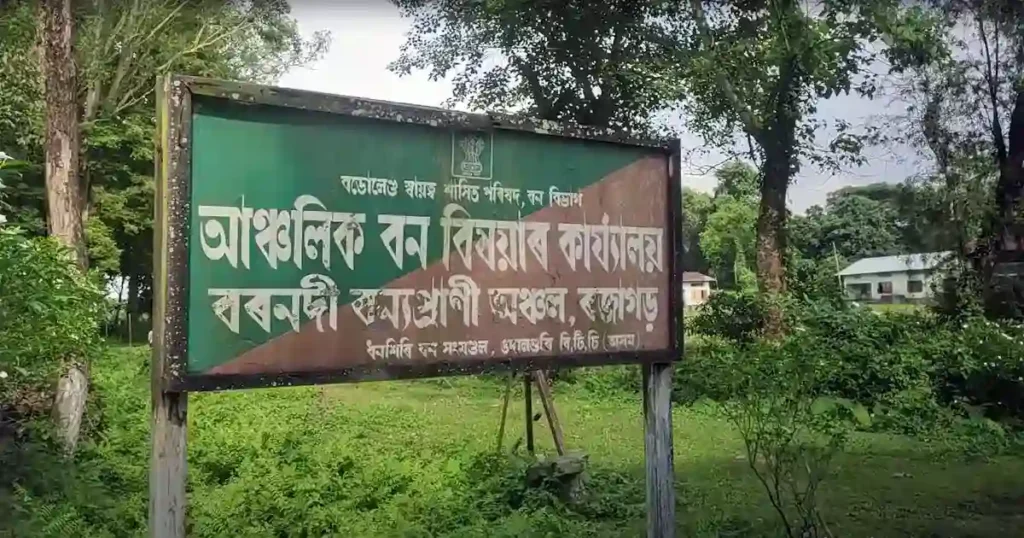
Flora and Fauna of Bornadi Wildlife Sanctuary
1. Flora
The Bornadi Wildlife Sanctuary boasts a rich variety of forest types within its habitats such as-
a) Pioneer Euphorbiaceous Scrub
b) Eastern Himalayan Moist Deciduous Forest
c) Eastern Hollock Forests-Terminalia Duabanga
d) Eastern Wet Alluvial Grassland
e) Khair-Sissoo Forests
These biodiverse ecosystems extend to the sanctuary’s ecological significance and support a wide range of plant and animal species. From the lush Eastern Himalayan Moist Deciduous Forest to the unique Eastern Wet Alluvial Grassland this sanctuary provides a shelter for various flora and fauna making it a vital conservation area in the region.
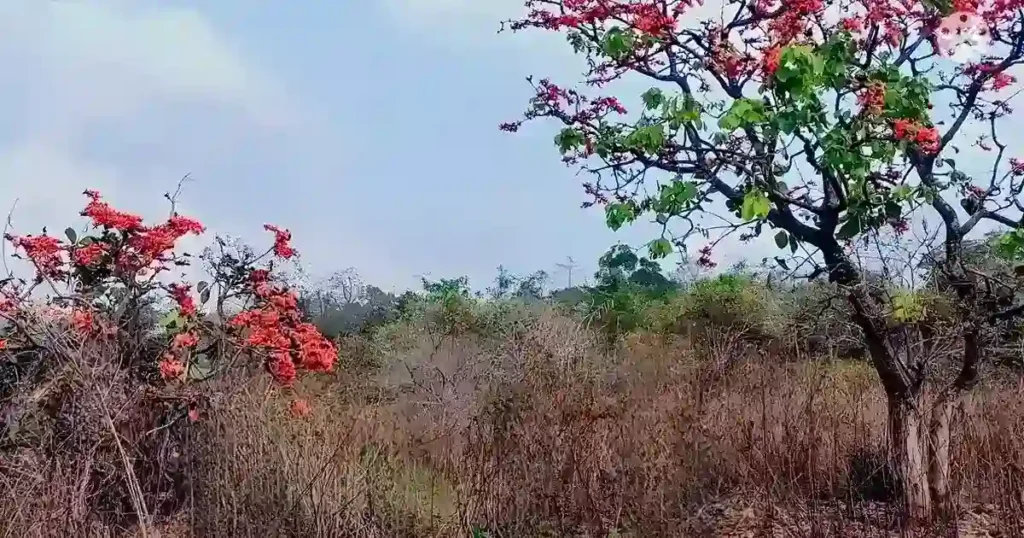
2. Fauna
a.) Mammals: Barnadi Wildlife Sanctuary is famous for the Pigmy Hog and Hispid hare. These two mammal species were once the flagship species of the area. The other common species habitat in the sanctuary is Asiatic Elephant, Royal Bengal Tiger, India Bison, Hog Deer, Wild Boar, etc. The other smaller mammals commonly seen in Barnadi Wildlife Sanctuary are Leopard Cats, Civet cats and Porcupine.
The Barnadi Wildlife Sanctuary’s habitat types is classified into seven major types – a) Woodland b) High density grassland c) Low density grassland d) Scrub Forest e) Degraded Forest f) River/ Water Body g) River sand/ Sandy area. The woodland patches extensively used by elephants within Bornadi Wildlife Sanctuary hold significant importance for their transboundary movements as all the corridors leading to Bhutan pass through these patches. The High-density grassland is used by the different species such as tiger, elephant, deer, etc. while the low-density grassland patches are extensively used by the wild boar and pigmy hog.
b.) Reptile: The common reptiles seen in Barnadi Wildlife Sanctuary are, Genus Python, Lissemys punctata, Kachuga tecta are common.
c.) Amphibia: The common amphibian species in Barnadi Wildlife Sanctuary are Eastern Hill Terrapin, Spotted Black Terrapin, Malayan Box turtle, Brown Roofed Turtle, etc.
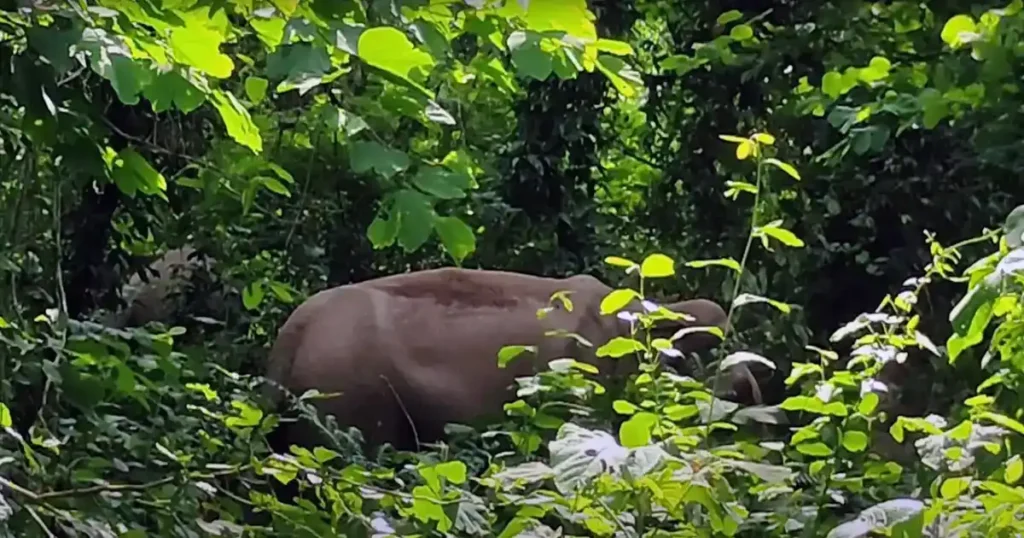
3. Aves:
The Barnadi Wildlife Sanctuary is rich in various bird species including the Bengal Florican which is a highly endangered bird in India. The other important available birds in Barnadi Wildlife Sanctuary are Great Cormorant, Little Cormorant, Little Green Heron, Large Egret, Chestnut Bittern, Pond Heron, Black, Bittern, Night Heron, Peacocks, Great Hornbills, King Fisher, Woodpecker, etc.
On May 10, 2022, around 6:00 AM a pair of Great Hornbills (one male and one female) was spotted at Rojagarh range office (26.7805 N & 91.7549 E) in Bornadi Wildlife Sanctuary. Female Great Hornbills have distinct features like a fully yellow casque, light iris and pink skin around the eye. These birds inhabit tropical rainforests, lowland and upland evergreen forests.
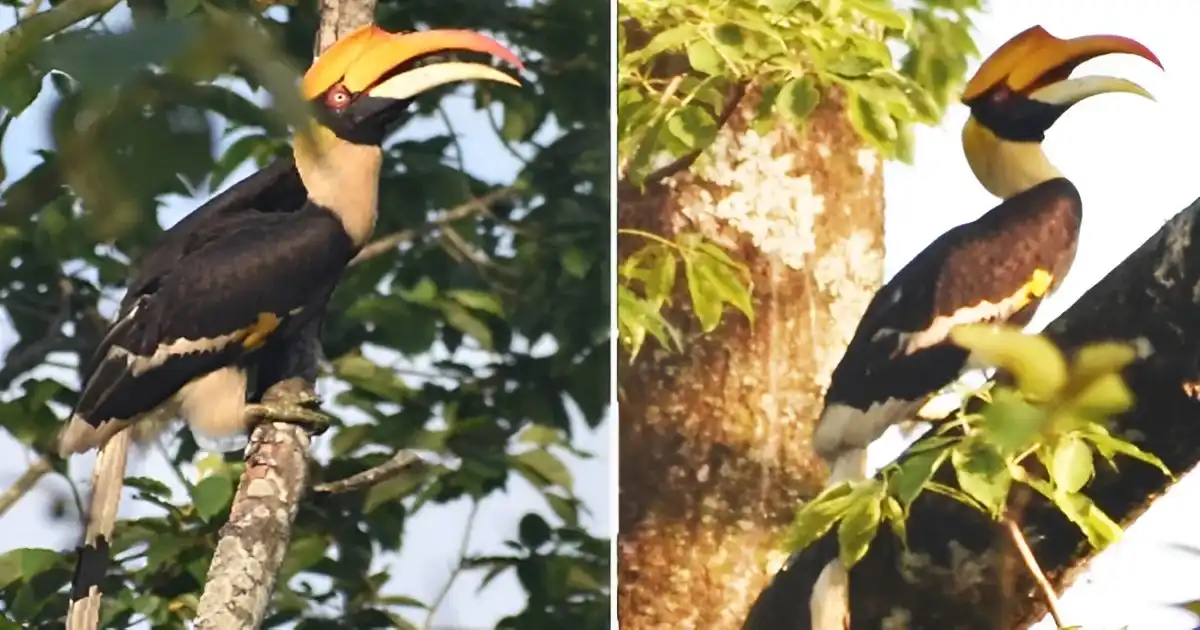
Best season to visit Bornadi Wildlife Sanctuary
The ideal time to visit Bornadi Wildlife Sanctuary is from November to March. During this period, it is transitioning from hot summer to cold weather. The weather is pleasant with average maximum temperatures around 25°C and minimum temperatures 7°C. The rainfall is relatively low averaging around 40–50 mm and the humidity stays at a comfortable 65%. It is an ideal time to explore the sanctuary and witness its natural beauty.
What you expect to see
1.) Mammals: Bornadi Wildlife Sanctuary offers an incredible opportunity to witness a diverse range of mammalian species including the elusive Hispid Hare, enigmatic Chinese Pangolin, majestic Gaur and the magnificent Tiger. You may also face the Leopard, Elephants, Barking Deer and the cunning Small Indian Civet. The sanctuary also boasts the presence of the Himalayan Black Bear and the unique Pigmy Hog making it a haven for wildlife enthusiasts and nature lovers alike.
2.) Birds: The sanctuary is sheltering to avian wonders such as the vibrant Swamp Partridge, elegant Bengal Florican, colorful Peafowl and majestic Hornbills etc.
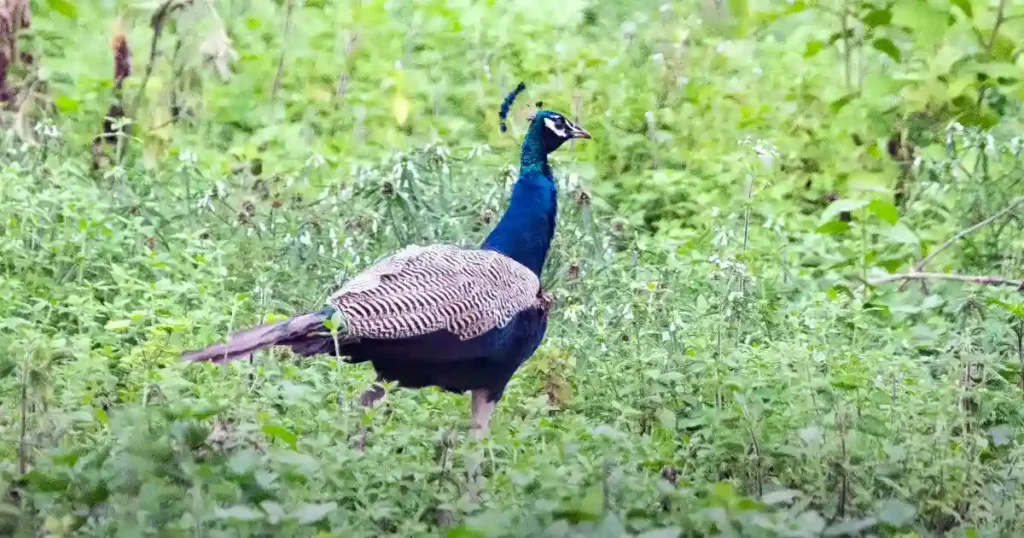
How to reach Bornadi Wildlife Sanctuary
The nearest Airport from Bornadi Wildlife Sanctuary is Lokpriya Gopinath Bordoloi International Airport, Guwahati which is about 150 kms. away. The Sanctuary is 70 kms. from Mangaldoi and about 120 kms. from Tezpur. The Rajiv Gandhi Orang National Park is 40 kms from Bornadi Wildlife Sanctuary.
Where to stay in Bornadi Wildlife Sanctuary
Visitors may stay in Circuit Houses at Mangaldoi and Udalguri as well as hotels in Guwahati.
There are exactly no hotels, lodges, or holiday homes near Bornadi Wildlife Sanctuary. If Circuit Houses are full, stay in Guwahati (150 km away), the capital of Assam with many accommodation options. Tezpur (130 km away), the Sonitpur district headquarters is another viable choice for lodging.
Conclusion
In conclusion, Bornadi Wildlife Sanctuary is a significant wildlife haven located on the foothills of the eastern Himalayas. It spans across Udalguri and Baksa Districts of Assam, India, bordered by Bhutan to the north. The sanctuary is named after the Bornadi River which serves as its western border. Established in 1980, it aims to protect endangered species like the hispid hare and pigmy hog. Visitors can encounter the diverse flora and fauna from November to March making it the best time to explore the sanctuary. While there are no accommodations directly nearby, Circuit Houses in Mangaldoi and Udalguri along with hotels in Guwahati or Tezpur offer comfortable lodging options for travelers.
FAQ
a.) What is Bornadi Wildlife Sanctuary famous for?
Bornadi Wildlife Sanctuary is famous for endangered species like the hispid hare and pigmy hog which led to its establishment in 1980. Rich wildlife biodiversity and other animals found in the sanctuary are deer, Himalayan goats, leopards and 218 bird species like the white-capped redstart, peafowl and blue magpie, along with 135 species of butterflies. The sanctuary’s Indu-Bhutan transboundary landscape acts as a vital elephant movement corridor between India and Bhutan.
b.) Where is Bornadi Wildlife Sanctuary situated?
The Bornadi Wildlife Sanctuary is situated on the foothills of the eastern Himalayas bordering Bhutan in the northwest of Udalguri district and the northeast of Baksa district of BTR, Assam, India.
c.) Bornadi Wildlife Sanctuary is famous for which animal?
Bornadi Wildlife Sanctuary is famous for endangered animals like the hispid hare and pigmy hog. Other animals found in the Sanctuar are white-winged wood duck, clouded leopard, golden langur and hoolock gibbon.
d.) Bornadi wildlife sanctuary is located in which district?
The Bornadi Wildlife Sanctuary is located in the northwest of Udalguri district and the northeast of Baksa district of BTR, Assam, India.
You Also May Like
- Garampani Sanctuary
- Laokhowa Wildlife Sanctuary
- Dibang Wildlife Sanctuary
- Nameri National Park
- Dibru Saikhowa National Park
References
- Spatial Modeling and Preparation of Decision Support System for Conservation of Biological Diversity of Barnadi Wildlife Sanctuary, Assam, India. Final Technical Report Submitted to Aaranyak and Rufford Small Grants Programme. Mr. Pranjit Kumar Sarma. http://www.indiaenvironmentportal.org.in/files/FINAL_BARNADI_REPORT_2008.pdf
- Faunal diversity in a semi-evergreen forest of Bornadi-Khalingduar Complex of Assam, India by Pallabi Chakraborty 1, Lalthanpuia 2, Tridip Sharma 3, Jimmy Borah 4, & Anupam Sarmah 5. https://pdfs.semanticscholar.org/ea0d/eef42c431b73d0abf53a950811ec24dc02b1.pdf
- Bornadi Wildlife Sanctuary | Government Of Assam, India.
https://udalguri.assam.gov.in/tourist-place-detail/271 - Wildlife Sanctuary | Government Of Assam, India.
https://forest.assam.gov.in/portlets/wildlife-sanctuary#Bornadi - Bornadi Wildlife Sanctuary.
https://en.wikipedia.org/wiki/Bornadi_Wildlife_Sanctuary - Bornadi Wildlife Sanctuary Assam.
http://www.assaminfo.com/tourist-places/40/bornadi-wildlife-sanctuary.htm

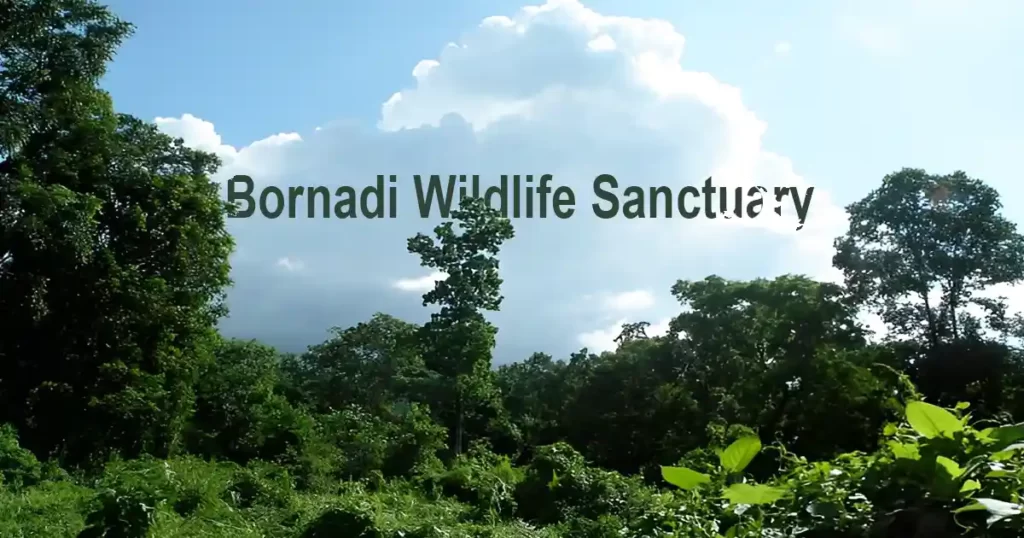
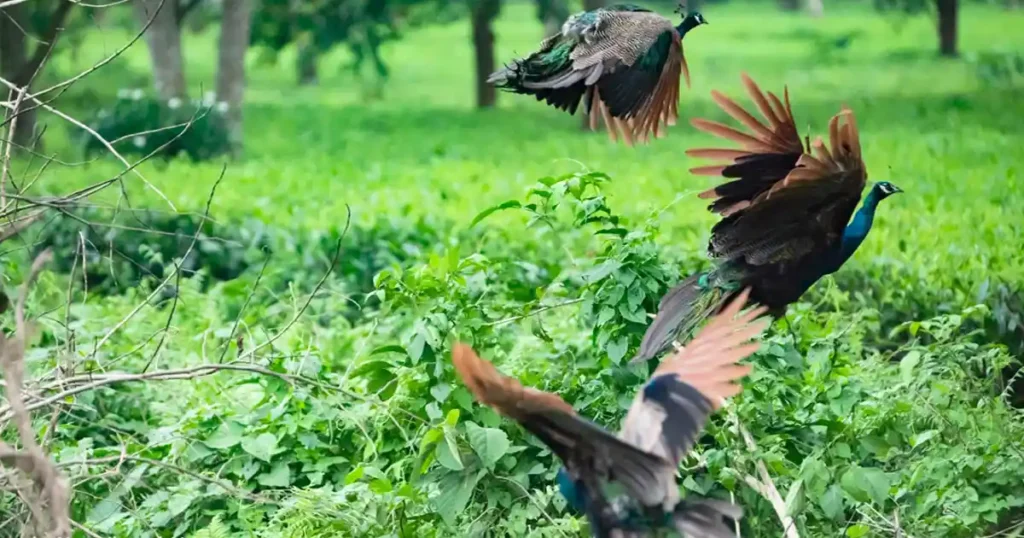
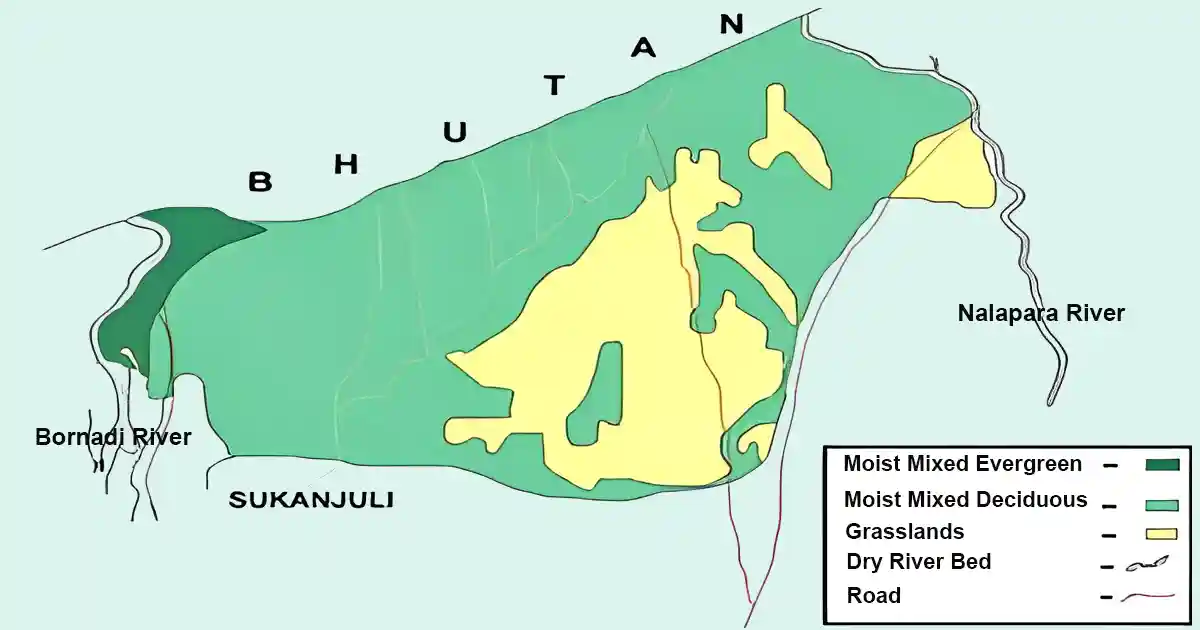
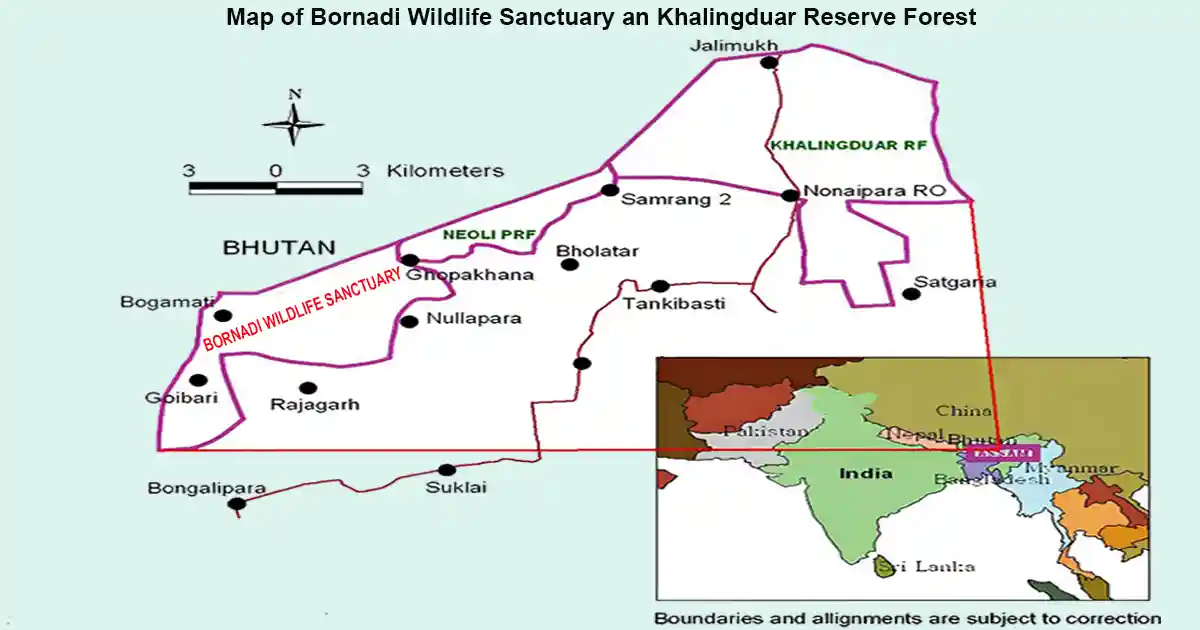
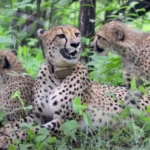
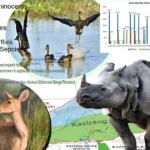
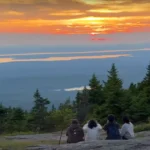
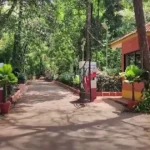
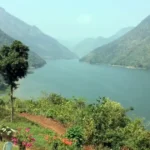


1 thought on “Bornadi Wildlife Sanctuary”